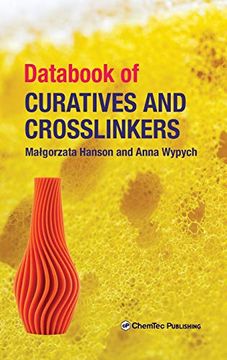Reseña del libro "Databook of Curatives and Crosslinkers (en Inglés)"
Forty groups of curatives/crosslinkers are included in Databook of Curatives and Crosslinkers. They include the following chemical groups of additives: acids, acrylamides, aldehydes, amides, amidoamines, amines, anhydrides, aziridines, borates, epoxy-functionalized polymers, carbamides, carbodiimides, chitosan derivatives, cyanamides, diols, glutarates, glycols, graphene oxide derivatives, hydantoin glycols, hydrazides, hydroxides, hydroxyl-containing moieties, imidazoles, isocyanates, isocyanurates, ketimines, maleimides, melamines, novolacs, peroxides, peroxyketals, phenols, polyols, salts, silanes, siloxanes, thiols, titanates, and ziconium derivatives. In total, 416 additives and included in the book.The additives discussed in the book have been suggested for use in 63 polymer and rubber types, as well as in 96 groups of products.The data for each curative/crosslinker are presented in a separate table. The information in the table is divided into five sections, including General, Physical properties, Health & safety, Ecological, and Use. The contents of these five sections is given below.General section contains the following fields: name, CAS #, acronym, acrylamide content, active content, active oxygen content, amine value, amine equivalent weight, assay, aziridine content, bio-based composition, borate content, chemical class, chemical composition, common name, cure schedule, EC number, empirical formula, formula, functionality, hydroxyl number, IUPAC name, moisture content, molecular mass, NCO content, RTECS #, SiH content, solvent, solids content, sulfur content, Ti content, water content, and Zr content.Physical section contains the following fields: acid #, activation energy, alkalinity, ash content, boiling point, color (description, Gardner, platinum-cobalt scales), density, dimer acids, freezing/melting point, gel time, glass transition temperature, half-life, kinematic viscosity, monomer acids, odor, particle size, pH, polymer acids, pot life, refractive index, solubility (in solvents and water), specific gravity, state, storage, surface tension, thin film set time, vapor density, vapor pressure, and viscosity.Health & safety section contains the following fields: ADR/RID class, autoignition temperature, HMIS (fire, health, reactivity), inventory status, carcinogenicity, DOT class, explosive LEL & UEL, eye irritation, flash point and method, first aid (eye, skin, inhalation), hazardous thermal decomposition products, ICAO/IATA class, IMDG class, ingestion, inhalation (rat LC50), LD50 (dermal rat and rabbit, and oral rat), mutagenicity, NFPA (flammability, health, reactivity), self-accelerating decomposition temperature, skin irritation, teratogenicity, TLV (ACGIH, NIOSH, OSHA), UN risk and safety phrases, and UN/NA class.Ecological section contains the following fields: aquatic toxicity (NOEC), LC50 (Bluegill sunfish, Daphnia magna, Fathead minnow, Rainbow trout, Zebra fish), bioaccumulation, bioconcentration factor, biodegradation probability, and partition coefficients.Use section contains the following fields: crosslinking process, crosslinking target, dose, food contact, formulation examples, manufacturer, optional curing time, outstanding properties, problems to avoid, reactive groups, recommended for products, recommended for resins, spacer arm length, suggested curing temperature, suggested maximum compounding temperature, and tips for application.In addition to this book which contains data on commercial additives, Handbook of Curatives and Crosslinkers has been published at the same time. The book includes information on mechanisms of action of these additives, methods of their use, their effects on properties of transformed products, their applications, etc.

